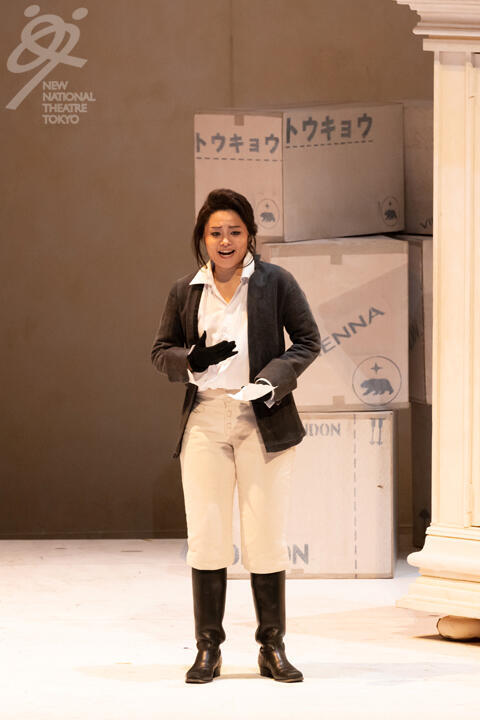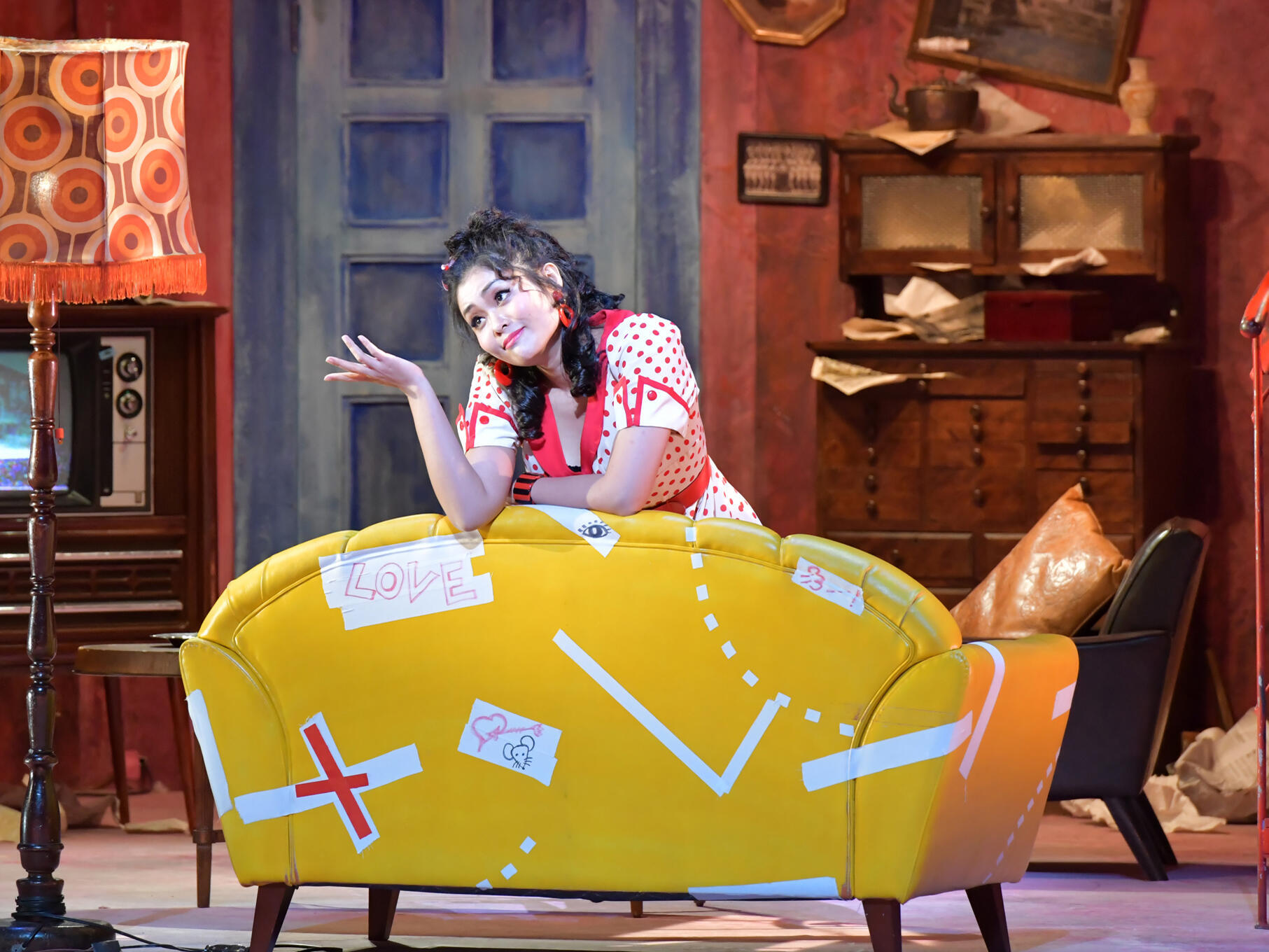Interview: WAKIZONO Aya on "La Cenerentola"
 ―Ms Wakizono, you are based in Italy. What is the current situation of the Italian opera houses, and how about your own circumstances?
―Ms Wakizono, you are based in Italy. What is the current situation of the Italian opera houses, and how about your own circumstances?
In Italy, opera houses were closed for a long period, but from this spring, they have slowly started to resume its activities. However, because they have to honor the contracts of the artists who were supposed to appear last year with alternative productions, they are not able to tackle much new repertoire at the moment. Personally, I was just switching repertoire when the pandemic happened, and for a while I didn't have any new auditions at all. Fortunately, things are starting to happen, and at the end of this year I will sing the role of Fenena in Nabucco in Germany. This situation will probably continue for a couple more years, so I'm spending my free time on learning new repertoire thoroughly. For example, I'm working on bel canto works such as Bellini's Norma (Adalgisa) and Donizetti's Tudor trilogy.
―I see, roles that will require more dramatic vocal colors than before. By the way, your Cherubino at the NNTT in February was wonderful. It was lyrical and sometimes melancholic, and I felt you played him more as a seductive youth than a boy.
I'm quite tall anyway, and when I thought about how I should play Cherubino, I decided it would be best to bring out a bit of seductive charm. Like the role of Romeo (in I Capuleti e I Montecchi) for example. It came quite naturally from within myself.
―In October, you will star in the season opening production at the NNTT. La Cenerentola is a prima donna opera, and the role of the heroine Angelina is a demanding role both in terms of acting and singing. You have already sung this role in Italy, haven't you?

Le Nozze di Figaro (2021)
I first sang the role in 2014 at La Scala in the "La Cenerentola per i bambini (for children)", which is a brilliant production reducing the work to about an hour. Subsequently, I have sung the role in Verona and Sassari. In Japan, I've sung it once at the Osaka International Festival. The role of Angelina is very special to me, and I've learnt so much from the role. It has taught me the importance of believing in something totally. Angelina has lived through difficult situations, but she transforms her own destiny through love. The work shows that even if you are under really difficult circumstances, you can change it if you have the will.
―Mr Aguni's new production is set in the Cinecittà studios in Rome, and the costumes pay homage to many classical films. Interestingly, he commented that the scene where Angelina and the Prince first meet is like the world of the film La La Land.
A little while ago, I went to Rome to meet Mr Alessandro Ciammarughi, the set and costume designer. I had a fitting in his studio too ― such pretty costumes! We found we have similar tastes in movies and we talked a lot about the Italian comedian Totò and also Hollywood classics. He showed me the set designs for La Cenerentola, which were like the world of my childhood dreams coming true! Angelina's dresses are reminiscent of Audrey Hepburn in Sabrina.
―I hear you last worked with Mr Aguni when you sang Donna Elvira in a production of Don Giovanni at Tokyo Geidai.
Exactly! It was a graduate school production and my opera debut. At the time, Mr Aguni was a lecturer at the university, so he's my teacher too. He taught us how to live a role, and the necessary technique for this. He showed us through detailed analysis how every small gesture of an opera character should be linked to the music. In other words, he taught us to be faithful to the basics of text and music in opera, which one could say is the Italian method. I'm very much looking forward to this collaboration.
―Could you share some of the highlights of La Cenerentola?
I would like to pick out the final scene of Act I. Cenerentola, who is transformed by Alidoro, makes her appearance at the palace, and everybody is wondering who she is. And her first words are "I despise those who pour capricious luck / Whoever wants to marry me, offer me respect, love, goodness". Rossini sets these words in virtuosic coloratura. It is an expression of how important this statement is for her character. For a woman's words in an opera composed in 1817, I think it's quite remarkable.
The other highlight is the scene (in Act I) where Cenerentola meets Don Ramiro. Until then, she had not known love, but when she meets him she experiences love for the first time. And when she decides that she wants to pursue this love, this becomes the turning point for her. Their encounter is followed by a magical duet, which is the most beautiful duet in the world.
―The rondo-aria Angelina sings at the end of the opera is another highlight, but the music is recycled from Count Almaviva's aria in Il barbiere di Siviglia.
Yes, the music is the same, but my view is that the energy of Il barbiere is different from that of La Cenerentola, and the emotions in the arias are also different. Whereas the Count's aria expresses the triumphant joy of winning Rosina, the rondo in La Cenerentola is the "triumph of goodness", which is part of the original title of this opera. When Cenerentola says "my vengeance is to forgive" before her aria, we feel her determination to start a new life, gaining strength from her past misfortunes.

Il barbiere di Siviglia (2020)
―What do you hope to achieve in this production?
I had been hoping to work with Mr Aguni for many years so I'm really looking forward. Also, as a big fan of Alessandro Corbelli, it's incredible to share the stage with this extraordinary artist. Mr Ciammarughi's staging is like the world of my childhood dreams come true. It's so beautiful. Appreciating such happiness, I hope I can convey the message that if you keep believing, your dreams will come true. We are still going through difficult times, but if I can share the energy to move forward with everyone, I couldn't be happier.
(Interview by INOUCHI Mika)
Opera "La Cenerentola"
On Stage from 1 to 13 October.
See here for more information.

